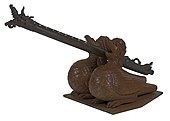
Kawaca is a term for war attire mentioned in Old Javanese texts. Its name comes from the Sanskrit kawaca which means armor, cuirass, a type of chain mail, any kind of cover, corset, jacket.
Description

Petrus Josephus Zoetmulder, in his Old Javanese-English dictionary, defines kawaca as a chain mail, possibly shaped like a jacket, which is made of metal. The word also has a second meaning, namely the shirt worn by the clergy. Irawan Djoko Nugroho argues that in a military context, kawaca means armor. It is shaped like a long tube and is made of cast copper. According to Jiří Jákl, kawaca was a metal breastplate worn on the upper body of a high-ranking soldier. In high Balinese language, kwaca or kuwaca is a general term for a jacket, although it used to mean armor in Old Javanese. In modern Javanese language, kawaca means cuirass or chain mail.
The Kakawin Ramayana (c. 870 AD), which is the Javanese version of Valmiki's epic Ramayana (c. 500 CE), mentions clothing and armor that reflect the era. A member of the royal family is said to wear crown, padaka (collar, medallion, or breastplate), karambalangan (girdle or plastron) and use gold-plated armor even in battle. Kakawin Ramayana also mentions the term watek makawaca, which means armored troops.
A suit of armor, or specifically cuirass, is depicted on the reliefs of the Divyavadana story in the Borobudur temple. In that story, it is said that Rudrayana sent a gift to king Bimbisara in the form of his famous cuirass which not only had miraculous powers but was also adorned with priceless gems. The cuirass is depicted as sleeveless and apparently closed in front.
See also
References
- ^ Nugroho, Irawan Djoko (2011). Majapahit Peradaban Maritim. Suluh Nuswantara Bakti. ISBN 978-602-9346-00-8.
- ^ Zoetmulder, P. J. (1982). Old Javanese-English dictionary. The Hague: Martinus Nijhoff. ISBN 9024761786.
- ^ Jákl, Jiří (2014). Literary Representations of War and Warfare in Old Javanese Kakawin Poetry (PhD thesis). The University of Queensland.
- Jákl, Jiří; Hoogervorst, Tom (2017). "Custom, Combat, and Ceremony: Java and the Indo-Persian Textile Trade". Bulletin de l'École française d'Extrême-Orient. 103: 207–235. doi:10.3406/befeo.2017.6248.
- Robson, Stuart; Wibisono, Singgih (2013). Javanese English Dictionary. Tuttle Publishing. ISBN 9781462910618.
- Tjoa-Bonatz, Mai Lin (2019). "JAVA : ARTS AND REPRESENTATIONS. Art historical and Archaeometric Analyses of Ancient Jewellery (7–16th C.) : The Prillwitz Collection of Javanese Gold". Archipel (97): 19–68. doi:10.4000/archipel.1018. S2CID 197855704.
- Wales, H. G. Quaritch (1952). Ancient South-East Asian Warfare. London: Bernard Quaritch.
- Krom, N.J. (1900). Barabudur: Archaeological Description Volume I. The Hague: Martinus Nijhoff.
- Foucher, A. (1917). Beginnings of Buddhist Art and Other Essays in Indian and Central Asian Archaeology. London: Humphrey Milford.
| Indonesian traditional weapons, armors, and premodern gunpowder-based weapons | ||||||||||||||||||||
|---|---|---|---|---|---|---|---|---|---|---|---|---|---|---|---|---|---|---|---|---|
|    | |||||||||||||||||||
| ||||||||||||||||||||
| ||||||||||||||||||||
| ||||||||||||||||||||
This armour-related article is a stub. You can help Misplaced Pages by expanding it. |